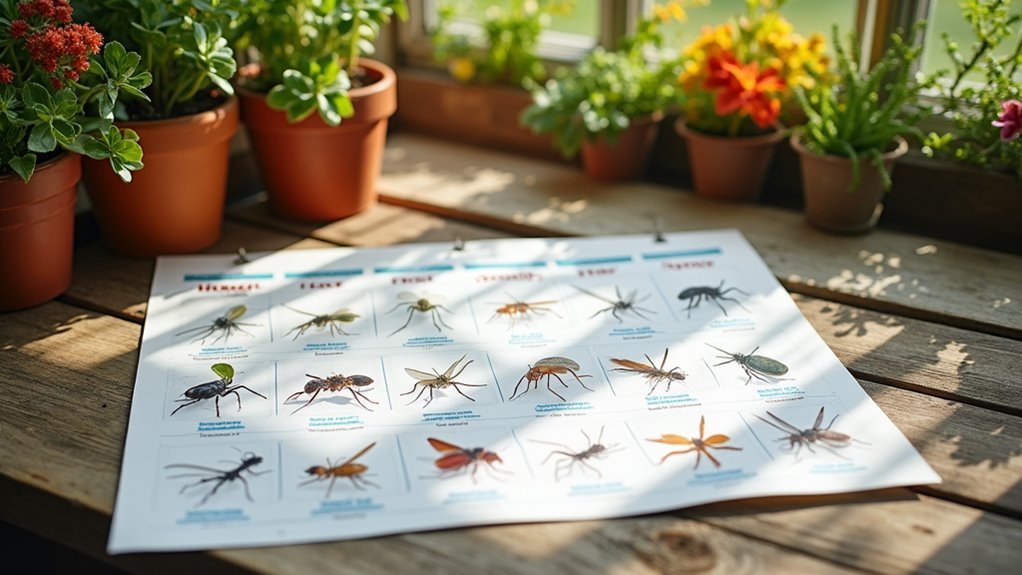You can prevent year-round pest problems by following a strategic seasonal schedule that targets specific invaders when they’re most active. Spring requires early intervention for ants and termites emerging from hibernation, while summer demands immediate action against mosquitoes and flies in the heat. Fall means sealing entry points as rodents and spiders seek indoor warmth, and winter focuses on blocking access to shelter-seeking pests. This complete approach transforms your pest control strategy from reactive to proactive.
Understanding Seasonal Pest Patterns and Behaviors

While many homeowners treat pest control as a reactive measure, understanding seasonal pest patterns transforms your approach into a proactive defense strategy.
Each season brings distinct pest activity that requires targeted responses. Spring’s warming temperatures trigger ant and termite emergence from hibernation, making early intervention critical to prevent infestations.
Summer’s heat and humidity accelerate mosquito, fly, and cockroach reproduction, demanding immediate action to eliminate breeding sites.
Fall pushes rodents and spiders indoors as they seek warmth, requiring enhanced sealing efforts.
Winter drives pests like rodents deeper into your home for shelter.
Winter Pest Prevention: Protecting Against Cold-Weather Invaders
When temperatures drop, rodents, cockroaches, and spiders aren’t just looking for shelter—they’re targeting your warm home as their winter refuge.
You’ll need to focus on sealing every potential entry point, from tiny gaps around windows to overlooked utility openings that these cold-weather invaders exploit.
Professional pest control treatments become especially valuable during winter months, providing targeted protection that keeps these persistent pests from establishing themselves in your living space.
Common Winter Invaders
As temperatures drop and winter settles in, several unwelcome guests begin searching for the warmth and shelter your home provides.
These common pests become particularly active during colder months, making winter pest prevention crucial for homeowners.
The most frequent winter invaders include:
- Rodents – These persistent pests can squeeze through openings as small as a dime, requiring you to seal all potential entry points.
- Cockroaches – Extremely resilient creatures that thrive in cluttered, dirty environments and can survive harsh winter conditions.
- Stink bugs – Known for invading homes in large numbers during fall and releasing foul odors when disturbed.
To prevent pests from entering your home, maintain cleanliness, reduce clutter, and schedule regular pest control services.
Proactive winter measures guarantee year-round protection against these unwanted invaders.
Sealing Entry Points
Understanding these common winter invaders is only half the battle – you must also block their pathways into your home. Sealing entry points is your most effective defense against rodents and other pests seeking winter shelter.
Start by conducting thorough inspections around windows, doors, and utility openings where gaps around these areas provide easy access. Repair any cracks in your foundation, walls, and roof immediately.
Install weather stripping and door sweeps to prevent cockroaches and rodents from infiltrating your living spaces. Don’t overlook vents and chimneys – these common entry points require regular seal maintenance.
Additionally, store firewood away from your house and keep it elevated to avoid attracting termites and rodents. These proactive pest control measures greatly reduce winter invasions.
Professional Treatment Benefits
While sealing entry points provides excellent protection, professional pest control treatments offer extensive winter defense that DIY methods can’t match.
Professional pest control services deliver specialized expertise and advanced treatments specifically designed for cold-weather invaders like rodents, cockroaches, and bed bugs.
Here are three key advantages of professional pest management:
- Customized Treatment Plans – Experts assess your home’s unique vulnerabilities and create targeted strategies.
- Advanced Detection Methods – Professionals identify hidden pest access points you might miss during inspections.
- Preventive Pest Control Solutions – Year-round pest control programs provide ongoing protection beyond winter months.
Professional pest control treatments guarantee thorough coverage that maintains a pest-free environment throughout the season, giving you peace of mind when temperatures drop.
Spring Preparation: Getting Ahead of Emerging Pest Activity
As spring temperatures awaken hibernating pests like ants, termites, and mosquitoes, you’ll need to recognize the early warning signs of emerging activity around your home.
Watch for ant trails near entry points, mud tubes indicating termite presence, and standing water that attracts mosquitoes looking for breeding sites.
Implementing proactive treatment strategies now—such as sealing cracks, eliminating moisture sources, and scheduling professional inspections—can prevent minor pest emergence from becoming major infestations.
Early Warning Signs
Spring’s arrival triggers a massive awakening of pests that have spent the winter months dormant, making this season your most critical time for vigilant monitoring.
Early detection becomes essential as you’ll notice subtle changes that signal emerging pest issues.
Watch for these key warning signs:
- Ant trails appearing along baseboards, windowsills, or outdoor pathways
- Mud tubes on foundation walls indicating termite activity near entry points
- Increased wasp and bee activity around blooming flowers and eaves
You’ll also spot termite swarms near windows during warm spring days.
Eliminate standing water in gutters, planters, and yard debris to prevent mosquito breeding.
Don’t ignore these early indicators—they’re your opportunity to implement effective pest control solutions before minor problems become major potential infestations or recurring pest challenges throughout the year.
Proactive Treatment Strategies
Once you’ve identified early warning signs, implementing targeted prevention measures becomes your next critical step in maintaining a pest-free environment.
Effective pest control methods begin with sealing cracks and gaps around windows and doors, preventing pests from entering your home or business as temperatures rise.
Conduct thorough spring cleaning in basements and attics to eliminate potential habitats and secure food storage areas.
Remove standing water sources around your property to prevent mosquito breeding during warmer months.
Schedule early spring treatments to reduce serious infestation risks, particularly from structural-damaging pests like termites.
Regular inspections of outdoor furniture help identify areas needing pest-proofing.
These proactive treatment strategies create extensive barriers against emerging pest activity, ensuring year-round protection regardless of temperature drop or seasonal changes.
Summer Defense Strategies for Hot-Weather Pest Control

When temperatures soar and humidity levels climb, your home becomes a magnet for summer pests seeking shelter, food, and breeding opportunities.
Hot, humid weather transforms your house into an irresistible haven for invasive pests looking to establish their summer headquarters.
As temperatures rise, mosquitoes, flies, and cockroaches multiply rapidly, making proactive pest control essential during the summer months.
Your defense strategy should include:
- Eliminate standing water sources – Check gutters, flower pots, and outdoor containers where mosquitoes breed.
- Secure entry points – Inspect window screens, door seals, and weatherstripping to prevent pest infiltration.
- Maintain cleanliness – Store food sources in airtight containers, dispose of garbage frequently, and trim vegetation around your property.
Don’t wait for infestations to develop.
Schedule professional pest control treatments early in the season to establish protective barriers before pests establish colonies in your home.
Fall Maintenance: Preparing for Shelter-Seeking Pests
As autumn arrives and temperatures begin their steady decline, countless pests abandon their outdoor habitats in search of the warmth and security your home provides.
Your fall maintenance routine should prioritize sealing entry points around windows, doors, and foundations to block rodents and spiders from infiltrating your living spaces.
Focus on proper food storage by transferring items into airtight containers and cleaning spills immediately. These simple steps eliminate the food sources that attract hungry pests during cooler months.
Conduct regular property inspections to spot early warning signs like droppings or nests before infestations escalate.
Don’t forget exterior maintenance—trim overgrown vegetation and clear yard debris that creates hiding spots.
Consider scheduling professional treatment in early fall for thorough pest control that prevents winter invasions before they start.
Essential Monthly Tasks for Effective Pest Management

Twelve months of consistent vigilance form the backbone of successful pest prevention, requiring you to establish a routine that addresses the changing needs of each season.
Monthly Inspections become your first line of defense against Possible Infestations, allowing you to spot warning signs before they escalate into serious problems.
Your essential monthly checklist includes:
- Inspect and Seal Entry Points – Check windows, doors, and foundation cracks for new gaps that pests exploit.
- Clean Regularly – Vacuum thoroughly, store food properly, and eliminate clutter that harbors unwanted guests.
- Schedule Professional Treatments – Arrange quarterly visits to maintain thorough protection.
Monitor standing water sources monthly, as stagnant moisture creates breeding grounds for mosquitoes and other pests.
These consistent efforts will Protect Your Home year-round through proactive maintenance rather than reactive measures.
Creating Effective Barriers and Entry Point Prevention
While monthly inspections provide the foundation for pest prevention, creating physical barriers serves as your most critical defense strategy against unwanted invaders. To create effective barriers, you’ll need to seal cracks around windows, doors, and utility openings since even tiny gaps allow rodents and insects inside.
Install weather stripping and door sweeps for tight seals, and repair damaged window screens immediately to prevent flying insects from entering.
Entry point prevention extends beyond structural fixes. Maintain a clean environment by eliminating clutter that provides pest hiding spots. Store food in airtight containers and clean spills promptly to remove attractants.
Combine these barrier methods with regular inspections to identify new vulnerabilities before pests exploit them, ensuring year-round protection.
Natural and Chemical Treatment Options by Season
Beyond establishing strong physical defenses, you’ll need targeted treatment strategies that align with seasonal pest patterns and your personal preferences for natural versus chemical solutions.
Effective pest control requires strategic planning that matches treatment methods to seasonal pest behaviors and your preferred approach.
Spring brings emerging ants and termites that respond well to diatomaceous earth and essential oils, though severe infestations may require targeted insecticides for effective elimination.
Summer demands active mosquito and fly control using organic citronella and neem oil repellents, while rapidly multiplying populations sometimes necessitate synthetic chemical interventions.
Here’s your seasonal treatment approach:
- Spring/Summer: Combine natural repellents with chemical treatments as backup for overwhelming infestations.
- Fall: Apply preventive chemical barriers around entry points while using peppermint oil for rodent prevention.
- Winter: Focus on sealing entry points and residual insecticides, supplementing with natural traps.
Year-round integration of both natural and chemical methods maximizes your pest prevention success against season-specific threats.
Building Your Customized Annual Pest Control Calendar
Four strategic planning phases will transform your pest control efforts from reactive scrambling to proactive protection.
Start by identifying seasonal pest patterns in your area—ants and termites surge in spring, mosquitoes dominate summer, and rodents invade during fall. Your customized annual calendar should schedule quarterly pest control services targeting these predictable cycles.
Include monthly maintenance tasks like sealing gaps around windows and doors to prevent pests before they enter. Use your calendar to eliminate standing water during mosquito season and monitor for rodent activity as temperatures drop.
Regular updates based on seasonal trends and effectiveness guarantee your pest management strategies remain sharp.
This systematic approach creates a proactive defense system, keeping your home protected year-round through strategic planning rather than emergency responses.
Frequently Asked Questions
Is Year-Round Pest Control Worth It?
Yes, you’ll save up to 30% on repair costs while protecting your family’s health. You’ll prevent larger infestations, address seasonal pest patterns effectively, and enjoy peace of mind in your home year-round.
How Many Times a Year Should You Go to Pest Control?
You should schedule pest control at least twice yearly for basic protection. If you’re in high-risk areas or have recurring issues, quarterly treatments work better for thorough prevention and cost savings.
What Is the Hardest Pest to Get Rid Of?
Bed bugs are the hardest pest you’ll face. They hide in tiny crevices, resist pesticides, reproduce rapidly, and survive months without feeding. You’ll likely need professional heat treatments and specialized insecticides for complete elimination.
Do I Really Need Quarterly Pest Control?
You don’t absolutely need quarterly pest control, but it’s highly recommended. Regular treatments prevent serious infestations, reduce costly damages, and target seasonal pest patterns before they escalate into bigger problems.
In Summary
You’ve got the roadmap for year-round pest control success. Don’t wait for problems to appear—stay proactive with your seasonal schedule. Combine barrier prevention, targeted treatments, and regular maintenance tasks to keep your home protected. Remember, consistency’s your best defense against unwanted invaders. Stick to your customized calendar, adapt strategies as needed, and you’ll maintain a pest-free environment throughout the year. Your vigilance today prevents tomorrow’s infestations.





Leave a Reply